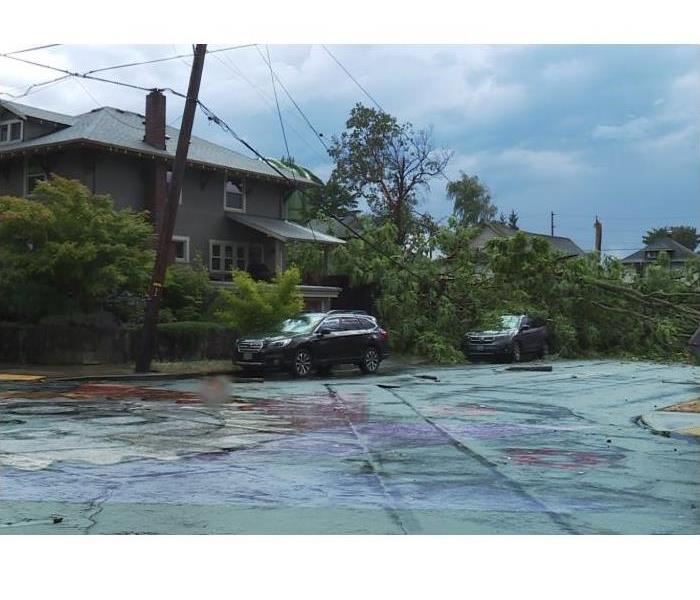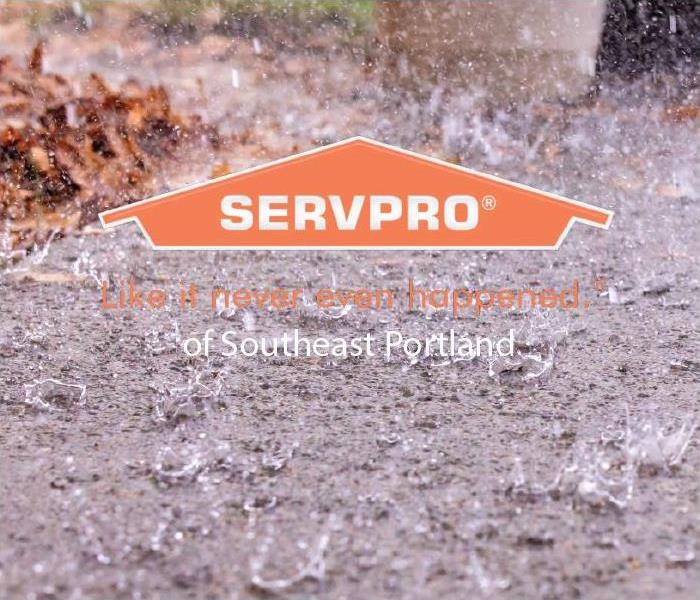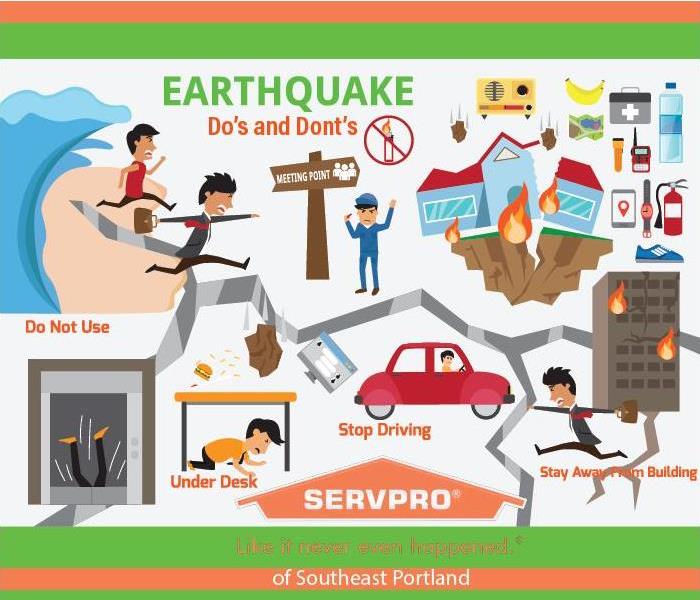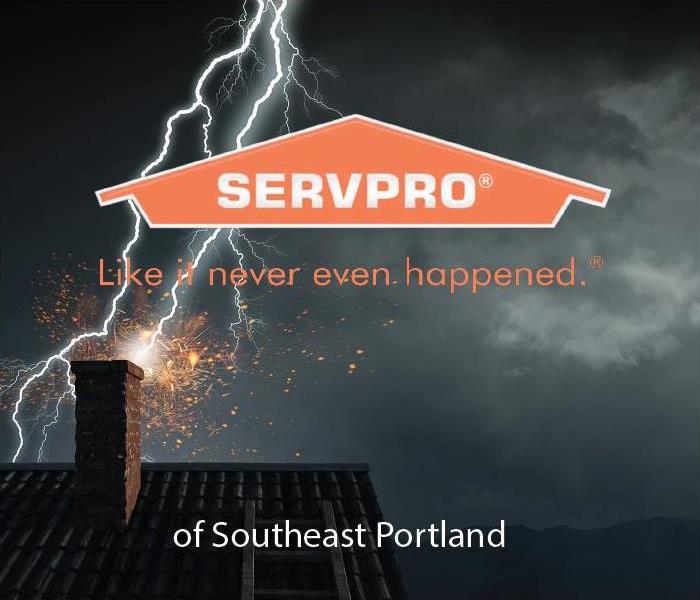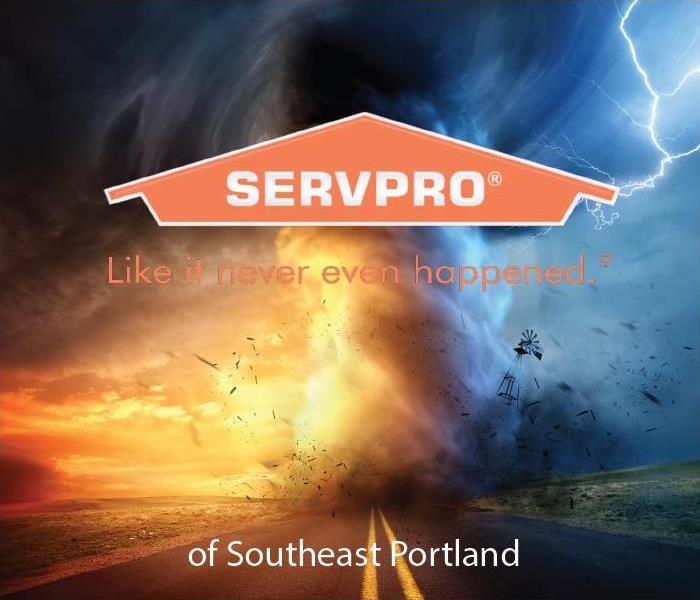Recent Storm Damage Posts
With Summer Coming to an End Here are Rainstorm Precautions
9/13/2022 (Permalink)
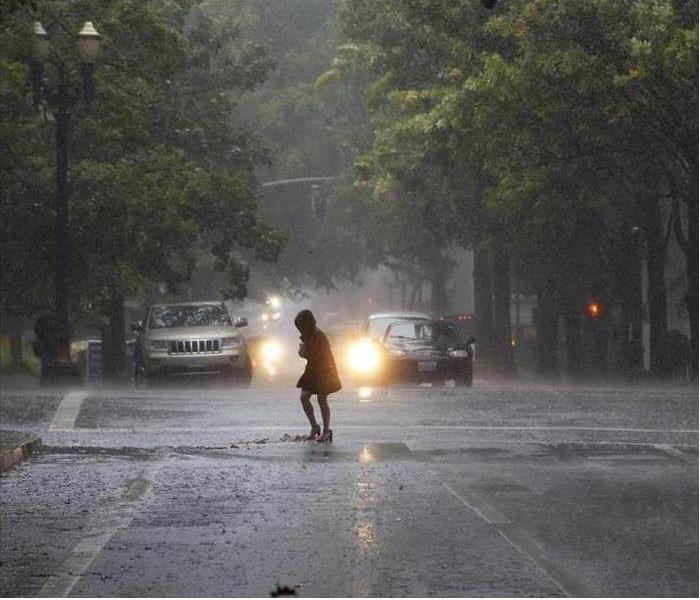 Call SERVPRO of SE Portland if you are experiencing any water damage in our home of office.
Call SERVPRO of SE Portland if you are experiencing any water damage in our home of office.
When a flood is happening you can take the following measures:
- Disconnect all electrical and gas appliances. Shut off the water main to keep contaminated water from the water heater (a source of emergency water).
- Bring any valuable or sentimental outdoor possessions inside.
- Move valuables and essential items to upper floors of building.
- Sandbags should be stacked well away from the building to avoid damaging walls. If major flooding is expected, flood the basement with clean water to equalize the water pressure on the outside of the basement walls and floors. This is to help prevent structural damage.
- Round up pets.
The extent of the flooding will impact the amount of work required to get your home back to its former glory. Minimal flooding may require only the time it takes to remove the water and dry everything out. More extensive flooding can leave you needing a complete remodel. Be prepared for the potential construction site left in your home after a flood.
Baddest in the West!
9/12/2022 (Permalink)
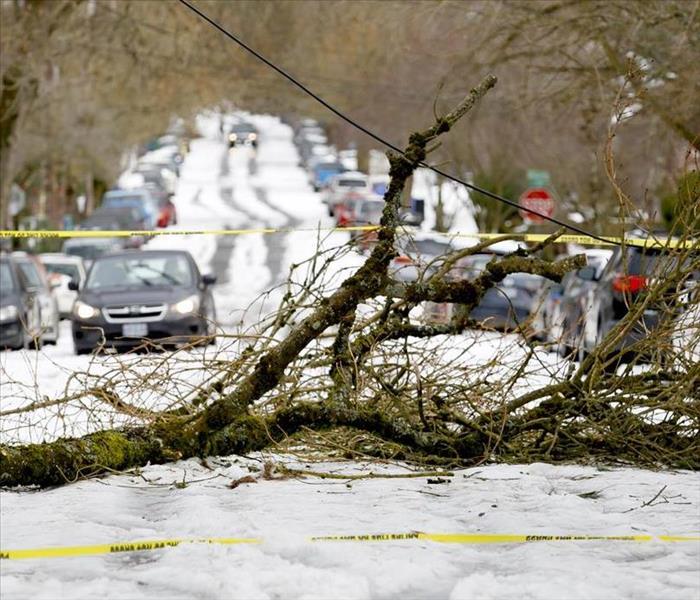 We are fully prepared and ready to help with anything that comes our way!
We are fully prepared and ready to help with anything that comes our way!
SERVPRO of Southeast Portland is the best choice for any size disaster. Our restoration company is great for three simple reasons. We are faster, properly equipped, and perfectly resourced.
As a locally owned and operated franchise, we will quickly travel to your location in the event of any disaster. As your neighbor, we will be there in a moments notice. We know just how frustrating and troubling a problem can be, and we never want our customers to have to wait during a stressful moment such as this. Our specialized teams can respond immediately to restore your property during a storm.
Here at SERVPRO of Southeast Portland we specialize in flood and storm damage and have an immense collection of tools and equipment to take care of any size disaster. We only use state of the art equipment and we are constantly updating our inventory to offer our customers the best service. If you need three fans, or well over 100, we have the tools and the team necessary to get the job done.
We are an independently owned franchise of the largest restoration company in the country. Our brand has grown to several thousand franchises because we have the resources necessary for any type of disaster at our disposal. Our outstanding Disaster Relief Team is strategically placed throughout the country to respond to any area immediately. Give us a call and we will be there to get your life back to normal.
What to do When Earthquake's Arise
9/12/2022 (Permalink)
 SERVPRO of SE Portland is always here to help you!
SERVPRO of SE Portland is always here to help you!
Knowing what to do in the event of a natural disaster or another unwelcomed event is crucial. Gathering a go-bag, plenty of food, water, and other survival supplies is strongly recommended to all Portland residents. Unfortunately, not all risks can be prevented or planned. The Pacific Northwest is sitting on a major fault line that is expected to slip within the next 50 to 500 years. Oregon also has neighbored some devastating earthquakes in the past. The most notable example being The Great 1906 San Francisco Earthquake. This disaster left thousands of casualties and destroyed close to 30,000 buildings. In 1989 there was the Loma Prieta San Francisco earthquake. This occurred during the World Series and many were in awe of the devastation this caused.
Preparing for such a disastrous event is almost impossible. However, when something falls down it is in our nature to pick up the pieces and rebuild. At SERVPRO of Southeast Portland, we fix what has been broken every single day we come into work. Whether it be an earthquake, a storm, or a fire breaks out; we will be there within a moments notice to make it “Like it never even happened.”
When Lightning Strikes...
9/12/2022 (Permalink)
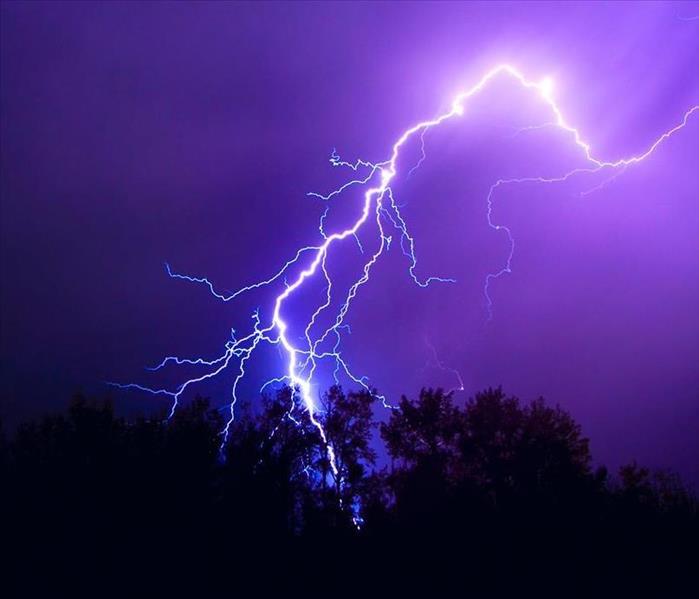 SERVPRO of SE Portland is always here to help!
SERVPRO of SE Portland is always here to help!
The odds of being struck by lightning is much more likely than that of winning at most games of chance including the Lottery. The actual odds for the average American to be struck by lightning is approximately 1 in 5,000 during their lifetime. On the bright side if you are unlucky enough to be struck you have a 9 out of 10 chance of survival on average. A more dangerous than being directly struck result of lightning is the fires it can cause.
Just last year in Oregon at this time at least 163 wildfires were detected in the state after 2,800 lightning strikes. In a few days the numbers had settled down to 47 fires that burned over 22,000 acres, according to the Department of Forestry. Lightning is quite often a sudden occurrence that sometimes is impossible to prepare for. Especially in the case of the beautiful uninhabited forests of Oregon. Luckily it is a rare occurrence that homes or buildings are the target of the lightning bolts.
Nationally United States fire departments annually respond to an estimated average of 22,600 fires that were caused by lightning. These fires caused an estimated average of nine deaths, 53 injuries and $451 million in direct property damage per year.
When we are called to an unfortunate situation you can rest assured that we will always be empathetic and professional. While we have no control over these lightning strikes or the devastating damage they cause, we can lessen the financial burden of the damage with our services. Our highly trained technicians at SERVPRO of Southeast Portland are always available to provide our fire restoration services no matter what the cause of the fire.
Even during Summer we can have Storms
7/22/2021 (Permalink)
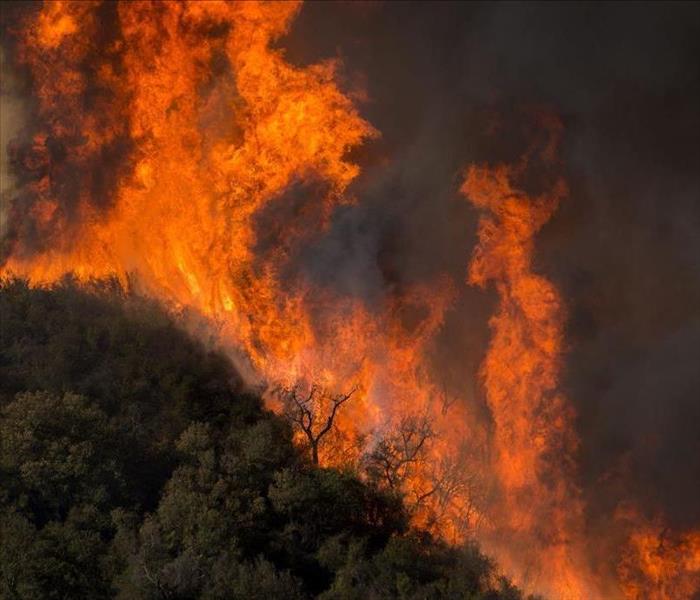 If you live next to an area where a wildfire can happen, stay calm and be prepared for any events to come!
If you live next to an area where a wildfire can happen, stay calm and be prepared for any events to come!
We are typically not thinking of Storms, during this Summer months. As here in Oregon many associate storms with rain, snow and ice. However, that is a misconception, with lack of normal rain fall we have been having we have new type of Storm, in which we should be aware of. We call this a “fire storm”. Oregon is dense in heavily populated forest in which people love to camp and have campfires. We also have periodic lightning strikes that creates fires. Natural disasters can occur at anytime and fire is one of the many outcomes. Here at SERVPRO we are ready and able to respond to any major storm event, including fires. If a fire storm causes damage to your property, we here at SERVPRO are here to help! 503-427-9535
Best in the West!
7/22/2021 (Permalink)
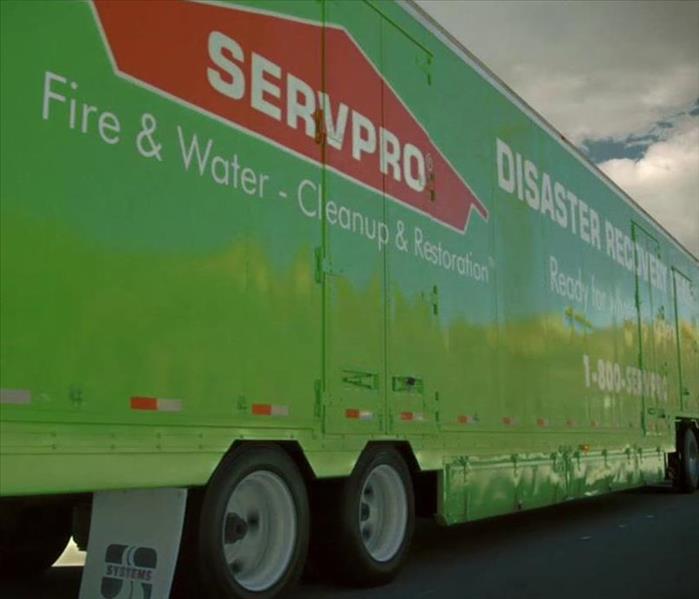 We are ready to help when disaster strikes!
We are ready to help when disaster strikes!
SERVPRO of Southeast Portland is the best choice for any size disaster. Our restoration company is great for three simple reasons. We are faster, properly equipped, and perfectly resourced.
As a locally owned and operated franchise, we will quickly travel to your location in the event of any disaster. As your neighbor, we will be there in a moments notice. We know just how frustrating and troubling a problem can be, and we never want our customers to have to wait during a stressful moment such as this. Our specialized teams can respond immediately to restore your property during a storm.
Here at SERVPRO of Southeast Portland we specialize in flood and storm damage and have an immense collection of tools and equipment to take care of any size disaster. We only use state of the art equipment and we are constantly updating our inventory to offer our customers the best service. If you need three fans, or well over 100, we have the tools and the team necessary to get the job done.
We are an independently owned franchise of the largest restoration company in the country. Our brand has grown to several thousand franchises because we have the resources necessary for any type of disaster at our disposal. Our outstanding Disaster Relief Team is strategically placed throughout the country to respond to any area immediately. Give us a call and we will be there to get your life back to normal.
Storms in Oregon and the Damage
6/28/2021 (Permalink)
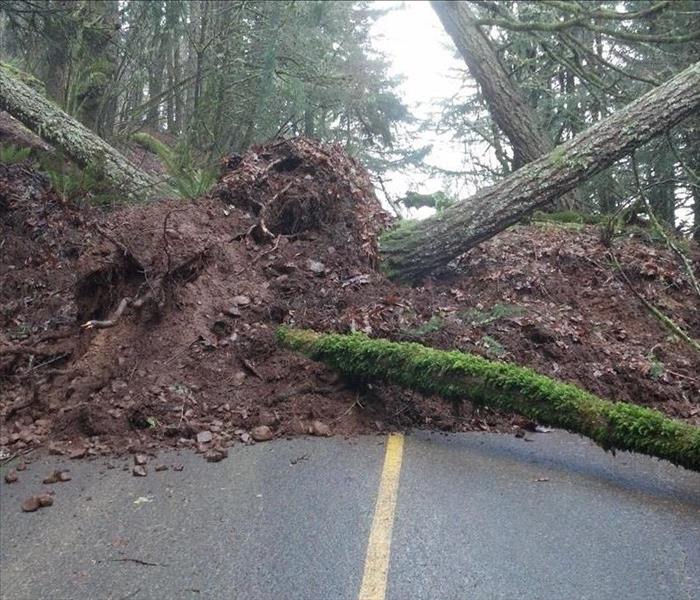 Don't be afraid call SERVPRO today! We are always here to help.
Don't be afraid call SERVPRO today! We are always here to help.
When you live in Oregon you think of heavy rain. Oregon’s annual rain fall totals range between 66-88 inches. Rain in Oregon can lead to an array of issues. Heavy down pours fill rivers and sewage pipes rapidly. This allows for flooding and clogged pipes. This also allows for massive saturation of land including yards. If continued water fall happens and winds pick up, trees can topple. We see here in Oregon many people fall victim to fallen tress causing damage to their homes. Here at SERVPRO we respond to this type of storm immediately and work with all of those involved to safely get the home secured and provide the additional steps on the reconstruction of the home. If you suffer from water damage, sewage issues or damage from a fallen tree call the us here at SERVPRO. 503-427-9535.
No need to worry, we are always here to help!
6/15/2021 (Permalink)
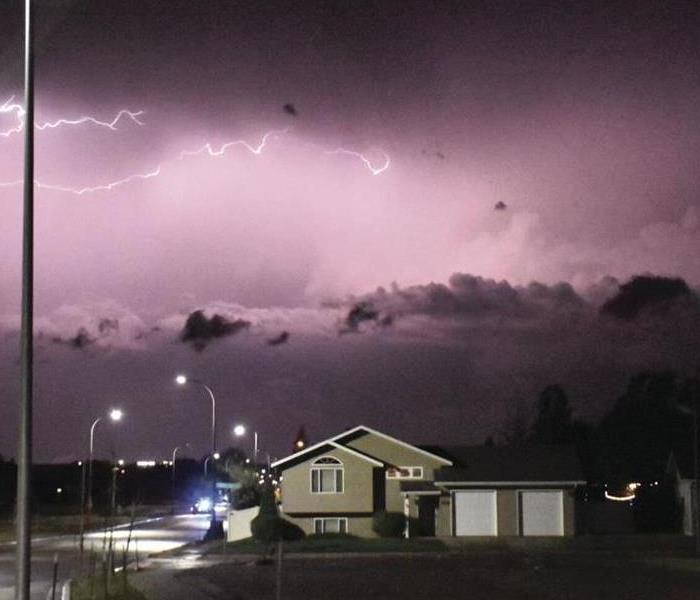 Contact us with any questions you have!
Contact us with any questions you have!
Unexpected emergencies like severe weather call for immediate action. SERVPRO of Southeast Portland knows immediate reaction to the disaster is important to helping you get life back to normal.
Using our 1-4-8 Service Response Guidelines, SERVPRO of Southeast Portland strive to:
- Contact you within 1 hour from notice of loss arrange for your service.
- Be on-site to begin mitigation services within 4 hours of notification.
- Provide verbal briefing of scope to you within 8 business hours of on-site arrival.
We can also perform pack-out services, which is removing salvageable personal property from the affected area for off-site cleaning and storage.
Since we are locally owned and operated, we can respond quicker with the right resources. A fast response lessens the damage, limits further damage, and reduces the restoration cost. We are available 24 hours a day, 7 days a week.
When storms hit Oregon we can scale our resources to handle a large storm or flooding disaster. We can access equipment and personnel from a network of Franchises across the country and elite Disaster Recovery Teams that are strategically located throughout the United States.
Tips to Making an Insurance Claim!!
6/15/2021 (Permalink)
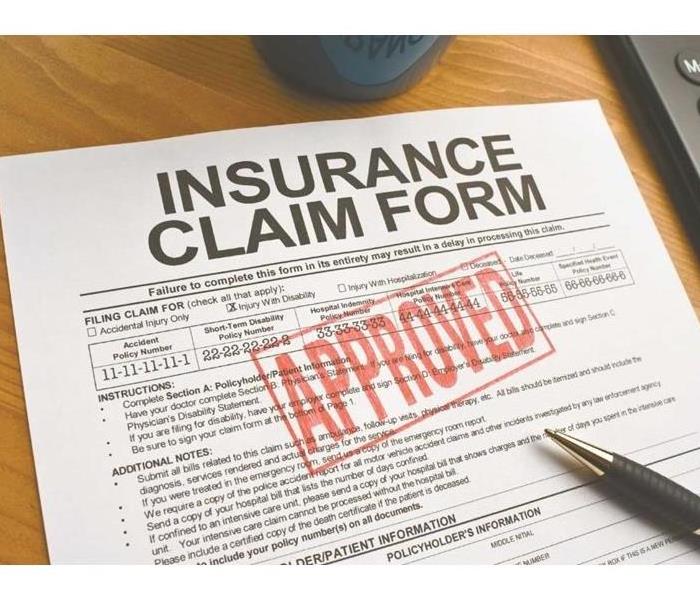 These tips will help you file a claim on your home!
These tips will help you file a claim on your home!
Sometimes Mother Nature likes to shake things up a little. If your home didn’t weather a storm as well as you hoped it would, we’ve got some tips to help you file an insurance claim for storm damage and get back on track quickly. Here’s where you should start.
Act quickly. Making a claim to your insurance company for damage in a timely matter is important for a couple reasons. Most insurance policies limit your time to file a claim, which makes being quick to connect essential. You’ll also want to repair the damage before it has a chance to get worse, so reporting your claim early is the best approach.
Review your policy. If you know what your homeowners policy and optional insurance covers, how to proceed and what you can expect from the process, you’ll be better prepared to plead your case. Every insurance policy and claim is different. Reviewing your policy gives you information that specifically applies to you.
Document everything. It’s smart to keep a log of the storm and the damage. Save news reports and take pictures immediately after to document any damage.
Get quotes from professionals. While your personal walk around and assessment is important, a professional opinion will be thorough and may mean more to your insurance provider. A great resource would be a storm repair contractor. They specializes in finding, assessing and repairing damage from storms and will check your home from roof to basement.
Be wary of scammers. Unfortunately, storm damage can bring scammers to your area with promises of quick and cheap repairs. Whether you’re filing an insurance claim or not, research anyone who offers to repair your home. Look for contractors who are licensed, insured and experienced.
Mitigate your damages. If the storm affected a large area, you may have to wait awhile before a storm assessor can review your damage and maybe even longer before you can get it fixed. In the meantime, you’ll want to take steps to prevent further damage. This could include tarping your roof, cleaning a wet basement, boarding up holes and more. Document the damage, then document how you’re taking steps to protect your property.
SERVPRO of Southeast Portland can assist with all your storm damage needs. Call us at (503) 427-9535
Fire Storms During the Summer
6/15/2021 (Permalink)
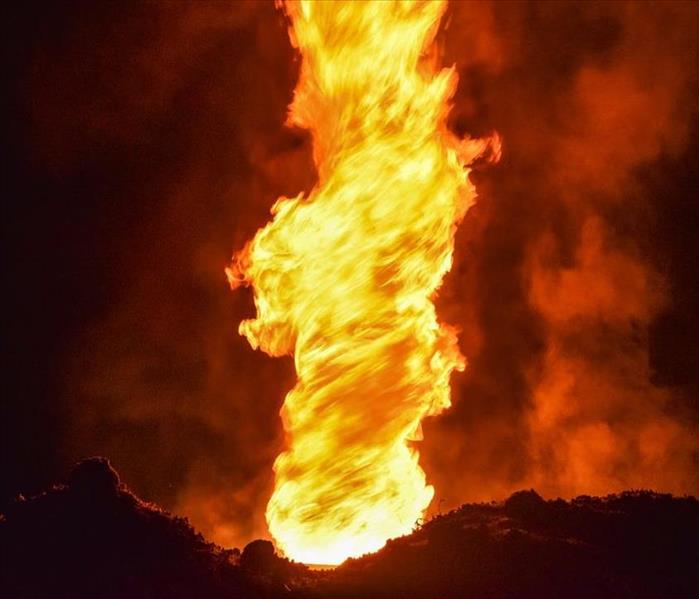 SERVPRO of Southeast Portland is here to help when a fire storm happens!
SERVPRO of Southeast Portland is here to help when a fire storm happens!
We here at SERVPRO anticipate the winds of summer and the sudden strike of a naturally caused or human inflicted fire storm. A firestorm is characterized by strong to gale-force winds blowing toward the fire, everywhere around the fire perimeter. These winds from the perimeter blow the fire brands into the burning area and tend to cool the unignited fuel outside the fire area so that ignition of material outside the periphery by radiated heat and fire embers is more difficult. What this means? If you have a property within the area of a firestorm, damage is inevitable. Here at SERVPRO we can protect the property and restore it to its original conditions. Weather is it a complete total loss and needs demo or simply smoke soot damage, we are here to help!
Check on Your Trees!
7/1/2020 (Permalink)
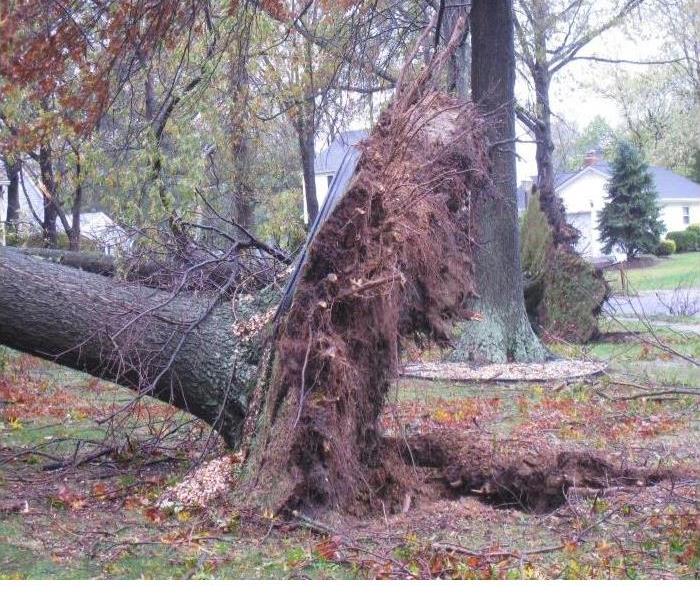 Roots Exposed on Tree Due to Falling Tree
Roots Exposed on Tree Due to Falling Tree
Summer storms can come on quick and swift leading to toppling trees, fires and major property loss.
Did you know that, when winds are sustained at 40-50mph, isolated wind damage is possible? Widespread significant wind damage can occur, causing major financial distress.
Recently in many parts of town, we had winds hitting the 40 mph. Streets were littered with debris and we witnessed branches and even trees tumbling. It is good house cleaning to get out in Springtime and analyze the roots of the tress on your property; if you see tree roots are getting too much water and not enough oxygen, it could lead to root rot, fungi or long-term tree stress. If roots are exposed and showing on the surface, this could mean they are dying. Also, prune and trim all branches. Limbs on trees with too much weight can cause breakage in storms.
Storms happen here in Oregon more off then not, so we suggest keeping on top of the care and wellbeing of your trees. If you do sustain damage from falling trees, wind damage, water damage due to storms. Call us here at SEVRPRO we are always here to help.
Storm Season during the Summer Months
7/1/2020 (Permalink)
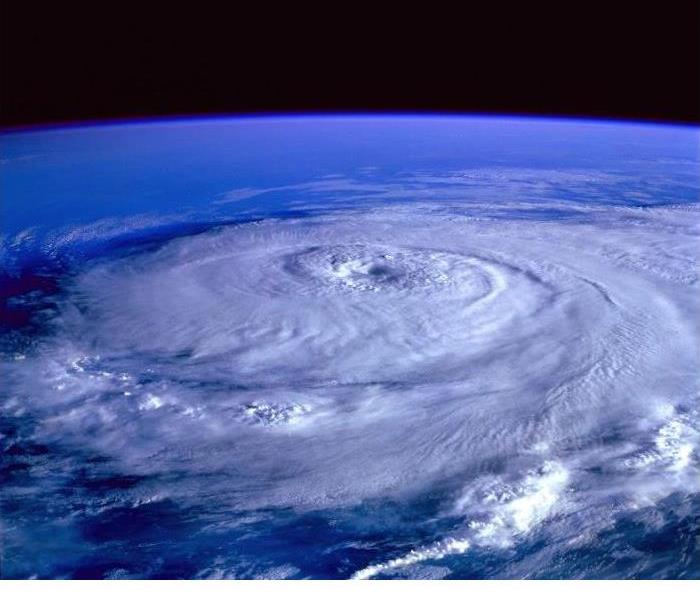 View of a hurricane from above satellite.
View of a hurricane from above satellite.
This time of the year we here at SERVPRO are gearing up for a time that we call STORM. Summer months bring many natural disasters around the world and here in the States. SERVPRO is a first responder to hurricane’s, flooding and wild fries. As each state has its own natural disasters, it seems they happen during the summer months. We here at SERVPRO have activated a team that is prepared to go and assist in other states. The past five years we have assisted our sister state of California in actively standing with homeowners during one of the most tragic times of their lives. After a fire has happened, we begin the regrowth with the client by; securing their property, assisting with knowledge on process of steps to take, providing machines to clean and restoring their property to its original condition. We here at SERVPRO look forward to helping fellow franchise owners when STORM seasons hit every year.
Family Disaster & Storm Preparedness in Five Easy Steps
6/22/2020 (Permalink)
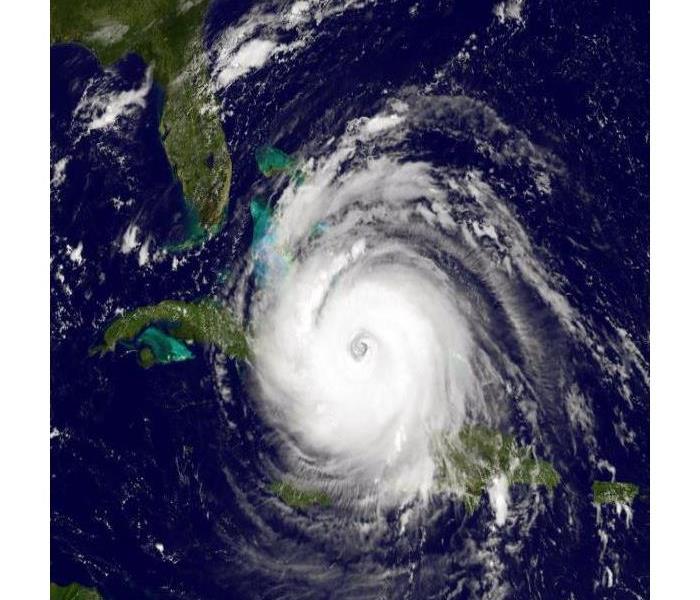 Storms are Unpredictable
Storms are Unpredictable
Weather and natural disasters can cause an array of issues pertaining to the security of your home and family.
- Discuss the disasters most likely to happen in Oregon and their impact on your family’s safety. Hazards in our area include home fires, winter weather, earthquakes, flooding and hazardous material threats.
- Train all family members. Take first aid classes. Learn to use a fire extinguisher and how to shut off utilities. Don’t’ take a chance that the only person who knows first aid or how to turn off the natural gas will be at home when needed.
- Assemble supplies including food, water and emergency tools.
- Complete an emergency names and number sheet. Provide to all family members. Post on your refrigerator, put one in with your supplies and give the list to someone outside of your home.
- Maintain your readiness. Review you plan at least once a year to determine what training, equipment and supplies are needed. Commit to a day or weekend to update phone numbers, hold fire and earthquake drills and check supplies.
- Add SERVPRO to your Emergency list 503-428-9585. We can also come out and offer you a emergency prepared training, showing you’re your emergency shut of values and assist in additional items you should be aware of in protecting your home and family for potential storm threats.
Recent Wind Storms in Oregon
6/15/2020 (Permalink)
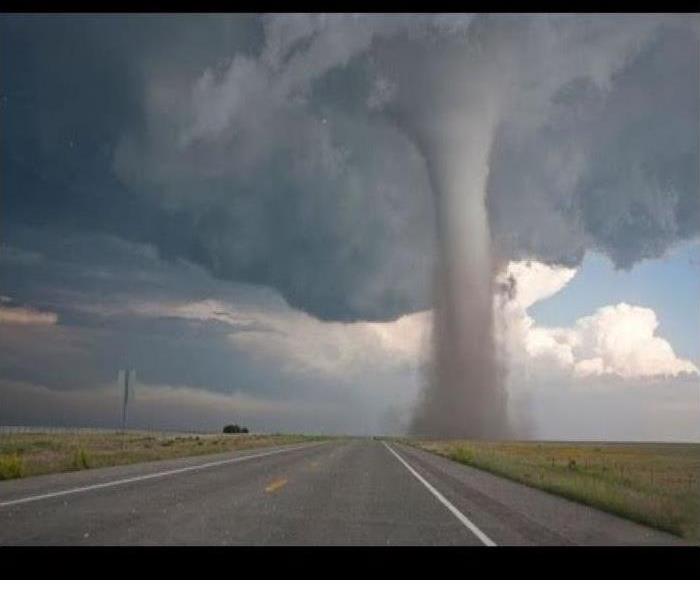 Funnel Cloud Touching Down
Funnel Cloud Touching Down
When people think of summer in the Northwest, they do not usually think of big storms and extreme weather events. They usually think of mild temperatures, sunny skies, and lots of people out and about enjoying the beautiful weather.
In the recent days in Damascus Oregon, located in Clackamas County, people reported seeing a funnel cloud and possible tornado. It was later confirmed that the funnel cloud was an EF-0 tornado. The storm swept through a man's property in Damascus. Winds knocked over a tree in his yard onto three cars.
Funnel Clouds do not ALWAYS turn into a tornado. In fact, storms can produce funnel clouds, but never produce a tornado. A tornado on the other hand, is when that rotating column of air, and that tight circulation reaches the ground, which can cause major damage. According to the National Weather Service, if you see a funnel cloud, move indoors to safety, then contact local law enforcement or the NWS in Portland.
If you are ever affected by a severe storm, like a tornado event, The SERVPRO Disaster Recovery Team can provide help. We are prepared to help in all types of storm events.
Is it Really June?
6/13/2020 (Permalink)
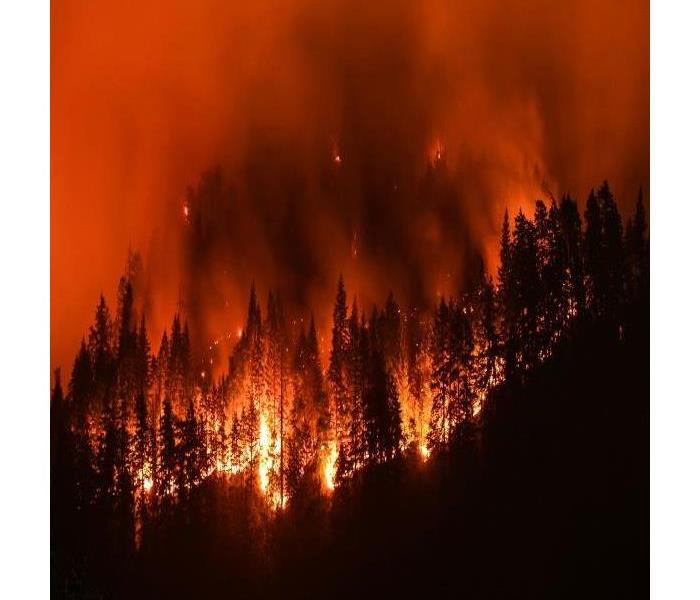 Wildfire burning rapid in a forrest.
Wildfire burning rapid in a forrest.
The weather here this month feels more like we are in April. Doesn’t it? With weeks of rain in the valley and fresh snow in the higher elevations, it does not feel like summer is here yet. However, this past week we experienced the clash in humid weather, giving us an abundance of lightening strikes around the town, showing us that the typical summer weather is fighting its way to us. Soon, we will have the longest set of days without rain. Which will lead to very dry weather and increased possibility of fire. We know this to be fire season. As the friends to the south typically have massive wildfires, we too are starting to see an uptick in larger wildfires during summer months here in Oregon. We encourage you to be prepared and have safety precautions in place. As emergency response providers, we will be here and ready when disaster strikes. Have your hose ready and know we are minutes away. Call us here at SERVPRO 503-427-9535
Summer Brings a Variety of Storms
6/13/2020 (Permalink)
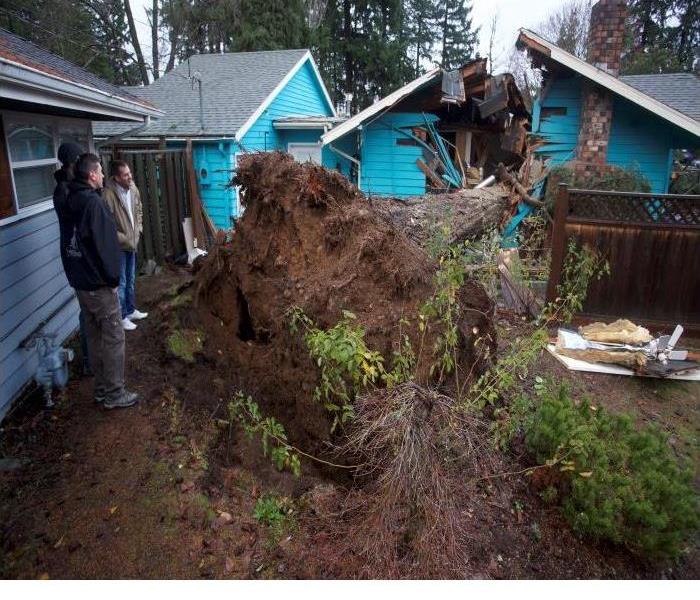 Tree fell on house due to storm.
Tree fell on house due to storm.
Here in the PNW, we are host to an ever-changing variety of weather patterns. Some call it the most bipolar weather place to live. One day we will have clear blue skies and 70-degree weather and the next it will be pouring rain and in the 40’s. The vast swiftly changing weather brings thunder, lightning, funnel clouds, hail and flash flooding. We will then turn to long spans of highly dry weather allowing for the forest to dry out and wildfires to start very easily. We here at SERVPRO call this time of the year Strom Watching. We always must be in tune and ready to respond to an array of potentially hazardous conditions. Our teams will be there to help protect, preserve and assist in any way, when mother nature takes its course. For Storm Damage Call SERVPRO 503-427-9535
A Tornado...In Portland?
7/9/2019 (Permalink)
When we think of the Portland weather tornadoes probably aren’t the first thing that comes to mind. It makes sense that residents of Portland don’t think about them since on average there are only three that occur in the entire state annually. While they are uncommon, just last week a tornado touched down in Northeast Portland.
Beginning with a hail and thunderstorm that crossed across Portland and Southwest Washington ended with toppled trees and power outages. A few trees fell and there was a report of one attic fire from the extreme weather. The positive to this severe for Portland weather is that was not any report of injuries from the storm.
As rare as it is for this type of storm to cause damage here in the great city of Portland, they do occur. If your home or business is unfortunate enough to sustain damages from this kind of weather SERVPRO of Southeast Portland is here to make it “Like it never even happened.”
The Best Chioce for Your Restoration Needs.
7/5/2019 (Permalink)
During the event of any size disaster SERVPRO of Southeast Portland is the best choice when choosing a restoration company for three simple reasons. We are faster, properly equipped, and perfectly resourced.
As a locally owned and operated franchise we will quickly travel to your location in the event of a disaster. As your neighbor we will be there the moment you need us. We understand how troublesome a problem can be, and we never want our customers to have to wait during a stressful moment of their life. Our specialized storm teams can respond immediately to restore your property.
Here at SERVPRO of Southeast Portland we specialize in flood and storm damage and have a network of tools and equipment to handle any size disaster. We only use state of the art equipment and we are constantly updating our inventory to offer our customers the best possible service. If you need three fans, or well over 100, we have the tools necessary for any sized job.
We are an independently owned franchise of the largest restoration company in the country. Our brand has grown to several thousand franchises because we have the resources necessary for any type of disaster at our disposal. Our world-class Disaster Relief Team is strategically placed throughout the country to respond to any area immediately. Give us a call and we will be there to get your life back to normal.
The Great Pacific North Wet!!!
6/25/2019 (Permalink)
Portland is no stranger to cold and rainy days. On average there is at least one form of precipitation in Portland over 150 days a year. We’ve seen record amounts of rain fall in recent years and have seen windstorms wreak havoc by toppling over 100 foot tall Douglas Firs into peoples’ homes. Downed power lines pose a greater risk than ones might think. A fallen tree can easily take a powerline right into your home as well, causing risk of electrocution and fire.
In the event of a power outage, snow in, or any other natural disaster it is important to be well stocked on supplies in case you cannot leave your home. There are many things that can go unnoticed during a disaster and attempting to pack last minute can leave you without something that will likely be essential to your wellbeing. The Department of Homeland Security has a fantastic guide on everything that should be in your basic disaster supplies kit. You can find that information and more here: https://www.ready.gov/build-a-kit
Are You Prepared if an Earthquake Hits Portland?
6/17/2019 (Permalink)
Risk management is an important aspect that every household, business, and government should put time and effort into. Having a go bag, plenty of food and water, and survival supplies in the event that you are separated from a resupply for up to 2 weeks is strongly recommended to all Portland residents. Unfortunately, not all risks can be completely prevented or planned for. The city of Portland is resting on top of some major fault lines that are expected to slip within the next 50 to 500 years. The Pacific Northwest has neighbored some major earthquakes in the past; most notably The Great 1906 San Francisco Earthquake that left thousands of casualties and destroyed nearly 30,000 buildings. More recently in 1989 I can remember vividly the images of destruction caused by the Loma Prieta San Francisco earthquake. This occurred during the World Series that year and I can remember being in awe of the devastation it caused as a child.
Preparing for such a catastrophic event is nearly impossible. However, as history shows we rebuild. When something falls down it is within our nature to pick up the pieces and remake something beautiful. At SERVPRO of Southeast Portland we fix what has been broken every single day we come into work. Whether the “Big One” hits, a storm knocks down a tree into your home, or a fire breaks out in your garage; we will be there within a moments notice to make it “Like it never even happened.”
How Dangerous is Lightning?
6/13/2019 (Permalink)
The odds of being struck by lightning is much more likely than that of winning at most games of chance including the Lottery. The actual odds for the average American to be struck by lightning is approximately 1 in 5,000 during their lifetime. On the bright side if you are unlucky enough to be struck you have a 9 out of 10 chance of survival on average. A more dangerous than being directly struck result of lightning is the fires it can cause.
Just last year in Oregon at this time at least 163 wildfires were detected in the state after 2,800 lightning strikes. In a few days the numbers had settled down to 47 fires that burned over 22,000 acres, according to the Department of Forestry. Lightning is quite often a sudden occurrence that sometimes is impossible to prepare for. Especially in the case of the beautiful uninhabited forests of Oregon. Luckily it is a rare occurrence that homes or buildings are the target of the lightning bolts.
Nationally United States fire departments annually respond to an estimated average of 22,600 fires that were caused by lightning. These fires caused an estimated average of nine deaths, 53 injuries and $451 million in direct property damage per year.
When we are called to an unfortunate situation you can rest assured that we will always be empathetic and professional. While we have no control over these lightning strikes or the devastating damage they cause, we can lessen the financial burden of the damage with our services. Our highly trained technicians at SERVPRO of Southeast Portland are always available to provide our fire restoration services no matter what the cause of the fire.
The Weather, Like Life, Can Be Unpredictable.
6/13/2019 (Permalink)
As we all know severe weather and storms can sometimes strike out of nowhere. Being prepared for a storm can help, but the damage left behind is inevitable. The damage varies by the type of weather disaster from winds, to floods and lightning. Once the storm is over SERVPRO of Southeast Portland is there to help restore your life back to normal.
There are many companies out there that advertise their ability to restore your home or business after a storm. But only those with proper training and certification should be considered. The Institute of Inspection Cleaning and Restoration Certification (IICRC) is the main oversight agency in this industry. The IICRC requires its registrants to take extensive coursework before earning their certification. This is a symbol of excellence, and those that uphold the standards that have been set can be contacted through the IICRC.
So, when weather is unpredictable you can count on us to help during these trying times. It is always our goal to provide you with the highest quality service to make the storm “Like it never even happened.”
When Storms or Floods hit Oregon, SERVPRO is ready!
6/4/2018 (Permalink)
SERVPRO of Southeast Portland specializes in storm and flood damage restoration. Our crews are highly trained and we use specialized equipment to restore your property to its pre-storm condition.
Faster Response
Since we are locally owned and operated, we are able to respond quicker with the right resources, which is extremely important. A fast response lessens the damage, limits further damage, and reduces the restoration cost.
Resources to Handle Floods and Storms
When storms hit, we can scale our resources to handle a large storm or flooding disaster. We can access equipment and personnel from a network of 1,650 Franchises across the country and elite Disaster Recovery Teams that are strategically located throughout the United States.
Have Storm or Flood Damage? Call Us Today (503) 427-9535
Protect Your Home from Storm Damage
6/4/2018 (Permalink)
Storms can be severe and leave a trail of destruction in their wake from flooding, strong winds and lightning.
Insurance claim costs are estimated to have reached astronomical amounts, with households suffering millions more dollars of uninsured financial losses dealing with the aftermath of those violent storms.
Worryingly, changing weather patterns means these damaging wind storms could become a regular winter staple, sweeping into parts of the country even earlier in the season. Preparing your home to cope can help to limit the damage that a storm may cause, including from flooding.
Thankfully, weather forecasting has improved and knowing if bad weather is on its way can be helpful in getting your house storm ready.
Did you know?
- The annual cost of storm damage can amount to millions each year.
- Thunderstorms develop when the atmosphere is unstable – typically forming a ‘cumulonimbus’ (rain/storm) cloud.
- These large clouds (often accompanied by large gusts of wind) can form in under an hour if the conditions are right – meaning there may not be much time before the storm hits!
Quick Guide to Preparing for a Storm
6/4/2018 (Permalink)
Quick guide to preparing for a storm
- Ensure your drains and gutters are clear of debris to prevent blockages.
- If safe to do so, check your pipes and water tanks are insulated to prevent freezing and that the release point of overflow pipes is not obstructed. Ideally, you'll have a regular maintenance programm in place.
- Cut back trees and branches to minimise the risk of falling branches.
- Secure loose fences.
- Check that roof tiles and aerials are secure if you can do this safely. It may be worth seeking professional advice.
- Make sure garden furniture and ladders are secured in case of high winds, or locked away in the shed or even inside your house.
- When you know a bad storm is on its way with warnings about gale-force winds and floods, make sure children, pets and your family and neighbors are safe. Make sure you're indoors when it hits and don’t try and repair damage during a storm.
Always be cautious when undertaking any task that you're not fully familiar with as you could injure yourself or those around you, seek professional help where required.
So, this winter, make sure you're storm ready. Secure loose objects such as ladders and garden furniture. Close and secure all windows and doors. Check on loved ones before a storm strikes, but once it arrives, stay indoors. Do not try to drive or move around outside near trees or buildings that could collapse.
SERVPRO of Southeast Portland offers inspections to make sure your home or business is storm ready. Call us at (503) 427-9535 for more information.
How Can Insurance Protect You?
6/4/2018 (Permalink)
Over the years SERVPRO of Southeast Portland has helped customers who have been forced to evacuate their homes to access temporary accommodation and pay for repair work. Aside from water damage, common problems from storms include collapsing roofs, fallen powerlines and smashed windows from falling trees, branches and other debris.
If you have home insurance, you should check what you could be covered for in the event your property is affected by a strong storm.
If your house has been affected, your insurer will help you to assess the damage, but it's important to understand that insurance companies will each have their own measure of what constitutes a storm. This will be a big factor in whether a claim will be accepted or not.
It's important to remember that you're responsible for maintaining your home in a good state of repair. If you're claiming for storm damage some insurers will ask you to confirm the date of the incident and show pictures of how the conditions at the time damaged your home. They may appoint one of their specialists to inspect your home or ask you to send them a report by your contractor.
Loss or damage to fences isn't covered by some policies, so make sure these are secure as they can be, to withstand a bad storm.
Powerful storm winds, rain and hail can cause car damage too, Vehicles can be swept off the road and engines flooded. If your car is damaged in a storm, this may be covered by insurance depending on your chosen level of cover.
6 Tips for Making a Storm Related Insurance Claim
6/4/2018 (Permalink)
Sometimes Mother Nature likes to shake things up a little. If your home didn’t weather a storm as well as you hoped it would, we’ve got some tips to help you file an insurance claim for storm damage and get back on track quickly. Here’s where you should start.
Act quickly. Making a claim to your insurance company for damage in a timely matter is important for a couple reasons. Most insurance policies limit your time to file a claim, which makes being quick to connect essential. You’ll also want to repair the damage before it has a chance to get worse, so reporting your claim early is the best approach.
Review your policy. If you know what your homeowners policy and optional insurance covers, how to proceed and what you can expect from the process, you’ll be better prepared to plead your case. Every insurance policy and claim is different. Reviewing your policy gives you information that specifically applies to you.
Document everything. It’s smart to keep a log of the storm and the damage. Save news reports and take pictures immediately after to document any damage.
Get quotes from professionals. While your personal walk around and assessment is important, a professional opinion will be thorough and may mean more to your insurance provider. A great resource would be a storm repair contractor. They specializes in finding, assessing and repairing damage from storms and will check your home from roof to basement.
Be wary of scammers. Unfortunately, storm damage can bring scammers to your area with promises of quick and cheap repairs. Whether you’re filing an insurance claim or not, research anyone who offers to repair your home. Look for contractors who are licensed, insured and experienced.
Mitigate your damages. If the storm affected a large area, you may have to wait awhile before a storm assessor can review your damage and maybe even longer before you can get it fixed. In the meantime, you’ll want to take steps to prevent further damage. This could include tarping your roof, cleaning a wet basement, boarding up holes and more. Document the damage, then document how you’re taking steps to protect your property.
SERVPRO of Southeast Portland can assist with all your storm damage needs. Call us at (503) 427-9535
Storm Damage Restoration Process
6/4/2018 (Permalink)
Violent weather such as storm damage can wreak havoc on buildings as well as vegetation. Wind damage can be a hazard to the structure of a building, by loosening the shingles or tiles on the roof. This can cause moisture such as rain and snow to infiltrate into the protective surface of the roof, which will result in the wood swelling and later on disintegration and becoming moldy. This outcome will lead to a sagging ceiling and further problems. Elements such as wind, rain, hail, and lightning can result in turning people’s lives upside down, this is why having a storm damage restoration service to help this type of emergency is a good option.
Here are some of the activities you can expect from the storm restoration service professionals.
- Whether it is a business or residence, the restoration company will come to your property and their trained experts will do a thorough examination of the interior and exterior of your building. This will help them discover the level of the damage. In many cases, the restoration company will discuss the renovation plans with you and your insurance adjuster.
- When everything is agreed upon, the work begins. Depending on what type of damage is present, this will determine the type of equipment the professional will use. In the case of flooding, they will use specialized pumps and vacuums to remove water from the affected areas.
- Generators will be brought in to operate their dehumidifiers and air movers so mold and mildew do not have a change to make matters worse. Using customized cleaners, the specialist will then disinfect hard surfaces and shampoo salvageable carpets as well as apply deodorant to combat any odors.
Important Facts To Know About Wind Damage
6/4/2018 (Permalink)
There are many areas of the United States that have experienced heavy winds and storms this season and the strong powerful winds can cause significant damage to a home. Wind damage and water damage are the most common results of a heavy storm and it is important to contact a storm damage restoration professional as soon as the storm is over to help limit and repair the damage. Wind damage can happen to your home directly from the strong wind or indirectly from the wind blowing debris into your house. These wind damage facts will help you better understand the potential for wind damage and how to prevent it.
Wind Type Varies by Storm and Causes Different Degrees of Wind Damage
Thunderstorms are the most common source of wind and storm damage but winds from hurricanes or tornadoes are stronger and can cause more severe damage. It is important to know when a storm is approaching your area and what type of storm it is so you know the potential and level of damage to expect. Thunderstorms are responsible for over half of all wind damage cases in the U.S. but the storm damage repair may be more costly for hurricane or tornado wind damage.
Characteristics of the Wind Affect the Wind Damage
The wind has many characteristics that differ depending on the situation. Some characteristics to take into account include speed, direction, and duration of the gusts and recognizing them can help you protect your home and property effectively from wind damage. Recognizing the characteristics of the wind can also help you determine how much potential damage to expect.
Preventing Wind and Storm Damage
Most wind damage is caused by flying debris either from plants or other structures and objects that are not secured. If a storm is approaching your area, make sure any potential debris around your home such as patio furniture, toys, garbage cans, and other objects are either secured or brought inside. Your doors and windows should also be secured to help minimize the potential storm damage to the home.
Winter Storms
6/22/2017 (Permalink)
WINTER STORMS
Severe winter storms can have a tremendous impact on individuals, animals, and communities. Cold temperatures, snow, ice, blizzard conditions with high winds and dangerous wind chills can all occur, leading to dangerous environments. Dangerous driving conditions can lead to travelers being stranded on the road. Accumulations of snow and ice can result in road closures or blockages – isolating homes and farms for days. The heavy weight burden may cause roofs to collapse or knock down trees and power lines resulting in power outages and subsequent loss of heat in homes. Winter conditions may make getting food and water to animals more difficult. Businesses must also make preparations for winter storm situations. Protection of their employees will be necessary to ensure their safety. Employees that must work outdoors during extreme situations should be provided the necessary education on risk and measures to stay safe.
Rain Storm Precautions
6/22/2017 (Permalink)
When a flood is happening you can take the following measures:
- Disconnect all electrical and gas appliances. Shut off the water main to keep contaminated water from the water heater (a source of emergency water).
- Bring any valuable or sentimental outdoor possessions inside.
- Move valuables and essential items to upper floors of building.
- Sandbags should be stacked well away from the building to avoid damaging walls. If major flooding is expected, flood the basement with clean water to equalize the water pressure on the outside of the basement walls and floors. This is to help prevent structural damage.
- Round up pets.
The extent of the flooding will impact the amount of work required to get your home back to its former glory. Minimal flooding may require only the time it takes to remove the water and dry everything out. More extensive flooding can leave you needing a complete remodel. Be prepared for the potential construction site left in your home after a flood.
Dangers of Rising Flood Waters
6/16/2017 (Permalink)
HIGH WATER
Rising floodwaters can take down forests from the roots.
After the Great Midwest Flood of 1993, which caused nearly $20 billion in damage and covered 400,000 square miles, nearly all the trees in four stands of Sanganois Wildlife Management Area near Beardstown, Ill., were submerged for more than six months and died.D
Whether it’s a river overflow or a coastal storm surge due to a hurricane, floodwaters can mean trouble for trees and forest ecosystems. First, floodwater currents, loaded with debris and silt, can erode the soils around shrubs and trees, exposing roots. In strong currents, debris may even strip bark from trees, uproot plants or strip shrubbery.
In addition to the initial physical impact, because many of a tree’s fine, oxygen-absorbing roots grow in the upper six inches of soil, these roots can die off as the soil becomes waterlogged. Without a robust root system, trees don’t absorb enough water and become weakened. As a result, foliage wilts or dies, and these weakened trees are a target for insects and disease.
The area around St. Louis, Missouri, in August 1993 after the Great Midwest Flood. Credit: NASA
Coastal flooding — often the result of a storm surge or hurricane — can cause significant damage by flooding freshwater areas with salt or brackish water. This saltwater intrusion can spell trouble for plants that rely on freshwater. Increased salts in the soil make it more difficult for tree roots to take up water because of changed osmotic pressure.
“The result is what’s called physiological drought. Even though there is water, the tree can’t take it up, and it’s the same as if there was no water,” explains U.S. Forest Service research ecologist John Stanturf of the Forestry Sciences Laboratory in Athens, Ga. “Under severe conditions, an already-stressed tree, such as one that has lost its leaves by shearing in hurricane winds, can’t recover and refoliate and may die outright.”
A few years after the Great Midwest Flood, land managers noticed that new shrubs and seedlings began to thrive in the affected areas, though the types of trees differed from the older, established stands that were killed by the flood. Some tree species — such as silver maple, green ash, sweet gum and black willow — are thought to be more tolerant to flooded soils than other trees like black locust, black walnut, tulip poplar, sugar maple and American beech. Regardless of species, though, it may take mature, surviving trees several years to recover from a summer of flooding according to the South Dakota Department of Agriculture.
Hurricane Effects
6/16/2017 (Permalink)
HURRICANE WARNING
When Hurricane Katrina struck the Gulf Coast on August 29, 2005, winds of speeds up to 140 mph toppled trees and turned sand and debris into airborne sandpaper, stripping any trees or shrubs left standing of their leaves or limbs.
Katrina’s damage extended as far north as Memphis, Tenn. A 2007 study published in Science used NASA satellite images to estimate 320 million trees dead or damaged in Mississippi and Louisiana alone from Hurricane Katrina. In combination with Hurricane Rita later that year, Hurricane Katrina was called “the largest single forestry disaster on record in the nation” by The Washington Post.
Damage inflicted by hurricanes depends on a variety of factors, including location, how the forest was managed and the age and height of a stand. While a loblolly pine plantation with trees 10 to 15 feet high may not sustain much damage, an older stand with 50-foot-tall trees of the same species would sustain more damage, according to Stanturf. In addition, because trees tend to support and protect other trees, there’s often more damage along openings in a forest, such as along roads or powerline swaths.
Beyond the wind damage, the storm surge that accompanied Hurricane Katrina damaged forests from the ground level. Sea waters surged more than three miles inland in some regions and more than 30 feet along much of the Mississippi coastline, causing the widespread damage inflicted by coastal flooding.
Forest recovery after a hurricane or other event depends on a particular forest’s management objective. Some hurricane-ravaged forests may be left to regenerate on their own, taking decades to a century to fully recover and reestablish. In some cases, cleanup is necessary to protect the forest from further destruction, as tree debris can become a breeding ground for insects and fungi. Other responses include salvage logging to recover the timber value that’s been lost and to reduce fire hazards, explains Stanturf. Seven years after Hurricanes Katrina and Rita, both replanted and surviving stands are recovering.
Deep Freeze
6/16/2017 (Permalink)
DEEP FREEZE
When heavy ice and wet snow coat tree limbs, the layers can be thick enough to break branches, twist limbs and crack tree crowns. Such an ice storm blanketed southern Missouri’s Mark Twain National Forest in 2009, snapping miles of telephone poles, limbs and trees.
After an ice storm or blizzard has passed through a forest, the first order of business is unblocking roads, especially roads that lead to residences, then clearing roads for larger vehicles. “We make sure people are safe first of all,” says Douglas Oliver, the Forest Service district ranger responsible for Mark Twain National Forest’s Poplar Bluff Ranger District. Then, trees are cleared from ditches, and workers ensure there aren’t hazardous trees or limbs dangling over recreation areas.
Similar to hurricane cleanup, timber may need to be salvaged before it rots and becomes worthless — or a breeding ground for pests. When the chainsaws stop, Oliver says, salvage teams have reported hearing swarms of insects boring into the downed wood. Such sheer volume of hungry insects can threaten nearby stands of surviving trees, likely weakened from the ice or wind.
Beyond insects, weakened, still-standing trees are vulnerable to disease and other physiological decline. At Mark Twain National Forest — where tornadoes and a 100-year flood have also occurred in the last five years — many surviving trees are more susceptible to ailments such as oak decline, which has afflicted red and black oak in the eastern U.S.
The summer after an ice storm or blizzard also can bring another danger. The layer of downed tree material can increase wildfire risk if conditions are extremely dry. Such a well-fueled fire could create catastrophic conditions to the point of soil sterilization, Oliver says.
The May 18, 1980 magnitude 5.2 earthquake triggered a major pumice and ash eruption of the volcano. Credit: U.S. Geological Survey
In ice- and snow-damaged areas, trees that sustain light to moderate damage can begin to regenerate within a few years as the forest ecosystem as a whole recovers, but after the worst storms, enough biomass may cover the ground that new seedlings from natural seed banks can’t break through. After the cleanups in the Missouri forest, Oliver says that occasionally forest managers will do supplemental planting — especially if a silviculturist determines the need for more pines, for instance — but many times replanting isn’t necessary, as the forest regenerates on its own in subsequent decades.
Tips To Staying Safe And Warm During Ice Storm Recovery
6/14/2017 (Permalink)
Ice and snow from winter storms can bring down trees and power lines, causing power outages and creating electrical dangers. Safe Electricity wants everyone to know how to stay safe and warm after winter storms.
If you must venture outside, be alert to the possibility of electrical hazards:
- Stay away from downed power lines and warn others to stay away. Be alert to the possibility that tree limbs or debris may hide an electrical hazard. Treat all power lines as live and dangerous. Treat everything near power lines as dangerous.
It can be difficult to stay warm without power. If you live with young children or the elderly, consider temporarily staying somewhere with power. If you are at a home with power, there are ways to stay warm:
- Stay inside and dress in warm, layered clothing.
- Close off unneeded rooms.
- When using an alternative heat source, follow operating instructions, use fire safeguards and be sure to properly ventilate.
- Stuff towels and rags underneath doors to keep the heat in.
- Cover windows at night.
Only use a generator if you know how to operate it without hurting yourself, or electric utility employees.
After an outage, power can return in spikes. Keep your electronics safe by unplugging them. Leave one light on to indicate that power has been restored then turn on other appliances and equipment one at a time.


 24/7 Emergency Service
24/7 Emergency Service
















